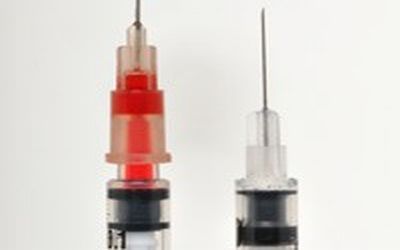Better Syringe Designs Could Nearly Eradicate Global Annual HIV Infections From Syringe Sharing


Switching the type of syringe used by people who inject drugs could help curb HIV transmission in countries with injection-driven epidemics within eight years, according to a new article by researchers at RTI International and Futures Institute.
The commentary, published in the January issue of International Journal of Drug Policy (IJDP), summarizes existing evidence regarding how low dead-space syringes can help reduce HIV transmission and estimates potential impacts on HIV transmission among people who inject drugs.
According to the authors, when a plunger on a syringe is fully depressed, all syringes retain fluid in what has been termed "dead space." In high dead-space syringes, 1,000 times more blood is retained in the syringe after washing than in low dead-space syringes.
This suggests that if a person who injects drugs shares a high dead-space syringe with an HIV-positive injecting partner, they are more likely to be exposed to HIV than if he or she shared a low dead-space syringe.
Using a simulation model, the authors found that switching to low dead-space syringes could lead to major reductions in HIV transmission in countries with injection-driven epidemics, such as China, Indonesia, Russia, Ukraine and Vietnam. According to the model, the change could reduce annual HIV infections from syringe sharing to nearly zero within eight years.
Although additional research is needed, this intervention should be implemented and evaluated as soon as possible, says William Zule, Dr.P.H., a senior research health analyst at RTI International and lead author of the paper. Switching from high dead-space to low dead-space syringes should be viewed as an additional component to comprehensive HIV prevention packages.
Preventing or controlling concentrated HIV epidemics among persons who inject drugs may also prevent the sexual diffusion of HIV from people who inject drugs to other groups.
While the low dead-space syringe still requires testing in targeted populations and there remains considerable work to be done on its implementation, nevertheless we ought to welcome the emergence of a potentially effective new tool in the fight against HIV, sayd professor Gerry Stimson, director of Knowledge-Action-Change and editor of the IJDP.
The paper also describes potential obstacles to transitioning from high dead-space to low dead-space needles and syringes and presents strategies for overcoming these barriers. Among the reasons low dead-space syringes have not yet been considered a viable prevention intervention include limited awareness of how needle and syringe design influence HIV transmission and a general lack of information about low dead-space syringes.
There are many difficulties related to scaling up effective HIV prevention programs in countries with HIV epidemics among persons who inject drugs, says Zule. This is a comparatively simple and low-cost intervention that has the potential to be extremely effective.
Source: RTI International
Â
Top 7 Infection Control Today Articles of 2024: Insights and Innovations
December 30th 2024From advanced sterilization methods to combating antimicrobial resistance, Infection Control Today’s top articles of 2024 delivered actionable strategies for safer healthcare environments and improved patient outcomes.
Revolutionizing Infection Prevention: How Fewer Hand Hygiene Observations Can Boost Patient Safety
December 23rd 2024Discover how reducing hand hygiene observations from 200 to 50 per unit monthly can optimize infection preventionists' time, enhance safety culture, and improve patient outcomes.
Redefining Competency: A Comprehensive Framework for Infection Preventionists
December 19th 2024Explore APIC’s groundbreaking framework for defining and documenting infection preventionist competency. Christine Zirges, DNP, ACNS-BC, CIC, FAPIC, shares insights on advancing professional growth, improving patient safety, and navigating regulatory challenges.
Addressing Post-COVID Challenges: The Urgent Need for Enhanced Hospital Reporting Metrics
December 18th 2024Explore why CMS must expand COVID-19, influenza, and RSV reporting to include hospital-onset infections, health care worker cases, and ER trends, driving proactive prevention and patient safety.